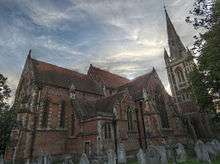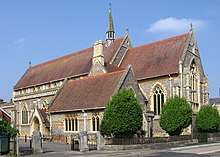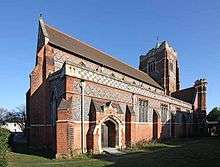John Oldrid Scott
John Oldrid Scott (17 July 1841 – 30 May 1913) was an English architect.
John Oldrid Scott | |
|---|---|
| Born | 17 July 1841[1] |
| Died | 30 May 1913 (aged 71)[1] Bexhill-on-Sea, England |
| Occupation | Architect |
| Spouse(s) | Mary Ann, née Stevens[2] |
| Children | Henry George Scott,[3] John Stevens Scott (24 May 1869)[1] |
| Parent(s) | Sir George Gilbert Scott and Caroline née Oldrid |
Biography
He was the son of Sir Gilbert Scott (George Gilbert Scott) and his wife Caroline (née Oldrid). His brother George Gilbert Scott Junior and nephew Sir Giles Gilbert Scott were also prominent architects. In 1868 he married Mary Ann Stevens, eldest daughter of the Reverend Thomas Stevens, founder of Bradfield College. One of his nine children, Charles Marriott Oldrid Scott, worked in his architectural practice.
At the end of his career he lived in Peasmarsh, near Rye, East Sussex, and the sale of his farmhouse and 136 acres was mentioned in the national press in 1928.[4]
Works
- St Stephen's Greek Orthodox Chapel, West Norwood Cemetery: started circa 1873[5]
- St. Peter's Church, Clayworth, Nottinghamshire: restoration 1874–75[6]
- St Michael and All Angels' Church, Stourport-on-Severn, Worcestershire: continuation of church designed by his father Sir G. G. Scott but unfinished at his death in 1881.[7] Partly demolished and replaced by a new church.

St Mary's Church, Slough
- St Mary's Church, Slough: construction completed 1878, subsequently extended 1911–13[8]

Interior of St Sophia's Greek Orthodox Cathedral, Bayswater
- St Sophia's Greek Orthodox Cathedral, Bayswater, London: 1878–79[9]
- St Mary's Church, Hayes, Kent: south aisle and transept, 1878–79[10]
- St Thomas of Canterbury's Church, Chester: completion of nave, 1881[11]
- University College Boathouse, Oxford: 1880–81[12] (destroyed by fire 1999)[13]
- St Laurence's Church, Frodsham, Cheshire: organ case,[14] 1882[15]
- St Bartholomew's Church, Hints, Staffordshire: 1882–83[16]
- St John the Baptist's Church, Halesowen, West Midlands: outer south aisle, 1883[17]
- St Mary the Virgin's Church, Adderbury, Oxfordshire: restoration, 1886[18]
- Cathedral Church of the Resurrection, Lahore: 1887
- St John the Baptist's Church, Alkborough, Lincolnshire: chancel rebuilt, 1887[19]
- St John the Baptist's Minster, Croydon, : Organ case, other interior designs 1888 [20]
- Mary the Virgin's Church, Thame, Oxfordshire: restoration, 1889–97[21]
- St Mary and St Peter’s Church, Harlaxton, Lincolnshire: restoration, 1890–91[22]
- St Denys' Church, Northmoor, Oxfordshire: rectory, 1891[23]
- St John the Baptist's Church, Kinlet, Shropshire: restoration, 1892,[24] and design of monument to Major CB Childe (killed 1900)[25]

St John the Evangelist's church, Boscombe
- St John the Evangelist's Church, Boscombe, Dorset: 1893–95 (with CT Miles)[26]
- St George the Martyr's Church, New Wolverton, Buckinghamshire: transepts, 1894[27]
- St Philip's Church, Hove: 1894–95[28]
- St Alkmund's Church, Duffield, Derbyshire: restoration, 1896–97[29]
- The Bute Hall, University of Glasgow: late 19th-century
- St. Mark's Church, Harrogate, West Riding: 1898[30]
- St Nicholas' Church, Piddington, Oxfordshire: restoration, 1898[31]
- St Michael's Church, Bournemouth, Dorset: tower, 1900–01[26]
- St Mary the Virgin's Church, Denby, Derbyshire: restoration, 1901–03[32]
- St Giles' Church, Wendlebury, Oxfordshire: restoration, 1902[33]
- Hereford Cathedral: west front, 1902–08[34]

St John the Evangelist's church, Palmers Green
- St John the Evangelist's Church, Palmers Green, Middlesex: 1903–08[35]
- St Mary and St Nicholas' Church, Compton, Berkshire: north aisle, 1905[36]
- St Albans Cathedral, Hertfordshire: organ case, 1905[37]
- St George the Martyr's Sunday School & Church Institute Building, New Wolverton, Buckinghamshire: 1907–08
- St Mary's Church, Princes Risborough, Buckinghamshire: rebuilding of west tower and spire, 1907–08[38]
- St Michael and St George's Cathedral, Grahamstown, South Africa: chancel and nave, dedicated 1912
gollark: Well, it's almost consistent with it being off by a factor of 100 somehow but why?
gollark: Your area is entirely the wrong magnitude.
gollark: Hmm, is this your "wellbeing robot" project?
gollark: It isn't a 2FA thing. Read the link.
gollark: Sure.
References
- "John Oldrid Scott". Our Family Genealogy Pages. Basil Halhed. Archived from the original on 24 September 2015. Retrieved 2 September 2015.
- "'". The Times (30227). London. 2 June 1913. col E, p. 11.
- "'". The Times (46988). London. 14 February 1935. col A, p. 1.
- "'". The Times (44918). London. 13 June 1928. col F, p. 7.
- Historic England. "West Norwood Cemetery and Crematorium (Grade II*) (1000851)". National Heritage List for England. Retrieved 2 September 2015.
- Pevsner & Williamson 1979, p. 98.
- Pevsner 1968, p. 271.
- St Mary's Church, Slough
- Historic England. "Greek Cathedral of Aghia Sophia and presbytery (Grade I) (1223553)". National Heritage List for England. Retrieved 2 September 2015.
- Newman 1976, p. 318.
- Pevsner & Hubbard 1971, p. 171.
- Sherwood & Pevsner 1974, p. 274.
- "Planning Application Number: 05/00893/FUL" (PDF). Oxford City Council. 2005-06-16. Retrieved 2018-04-11.
The boathouse was designed by John Oldrid Scott, 2nd son of George Gilbert Scott, and completed in 1880. Shortly after its construction it was burnt out in 1881, but rebuilt to its original designs in 1884. Its listed Grade II status probably derives in part from its connections with the Gilbert Scott family of architects but also from its contribution to the history of the development of boathouses in the late 19th century. Early history in college rowing depended on the use of rowing 'barges' of which very few now survive. The University College Boathouse was one of the early examples of the move of the boathouse onto dry land. Rather ironically in1999 the boathouse was once again subject to fire which effectively destroyed it and has led to these proposals to remove what is left and rebuild on the same site, but in a contemporary design.
- Pevsner & Hubbard 1971, p. 221.
- "Cheshire Frodsham, St. Lawrence [H00016]". National Pipe Organ Register. 2018. Retrieved 16 September 2018.
- Pevsner 1974, p. 148.
- Pevsner 1968, p. 180.
- Sherwood & Pevsner 1974, p. 413.
- Pevsner & Harris 1964, p. 168.
- Lamport, Tim. "History". Croydon Minster. Archived from the original on 24 March 2012. Retrieved 19 January 2019.
- Sherwood & Pevsner 1974, p. 806.
- Pevsner & Harris 1964, p. 560.
- Sherwood & Pevsner 1974, p. 723.
- Pevsner 1958, p. 160.
- Francis 2013, p. 47.
- Pevsner & Lloyd 1967, p. 124.
- Pevsner 1960, p. 300.
- Historic England. "Church of St Philip (Grade II) (1187579)". National Heritage List for England. Retrieved 16 February 2014.
- Pevsner & Williamson 1978, p. 201.
- Pevsner & Radcliffe 1967, p. 248.
- Sherwood & Pevsner 1974, p. 731.
- Pevsner & Williamson 1978, p. 165.
- Sherwood & Pevsner 1974, p. 832.
- Pevsner 1963, pp. 146, 153.
- Historic England. "Parish church of St John the Evangelist, Palmer's Green with parish room (Grade II*) (1078929)". National Heritage List for England. Retrieved 2 September 2015.
- Pevsner 1966, p. 120.
- Pevsner & Cherry 1977, p. 307.
- Pevsner 1960, p. 225.
Sources and further reading
- Brodie, Antonia; Felstead, Alison; Franklin, Jonathan; Pinfield, Leslie, eds. (2001). Directory of British Architects 1834–1914. L–Z. London & New York: Continuum. ISBN 082645514X.
- Francis, Peter (2013). Shropshire War Memorials, Sites of Remembrance. YouCaxton Publications. p. 47. ISBN 978-1-909644-11-3.
- Newman, John (1976) [1969]. West Kent and the Weald. The Buildings of England. Harmondsworth: Penguin Books. p. 318. ISBN 0-14-071038-8.CS1 maint: ref=harv (link)
- Pevsner, Nikolaus (1958). Shropshire. The Buildings of England. Harmondsworth: Penguin Books. p. 160.CS1 maint: ref=harv (link)
- Pevsner, Nikolaus (1960). Buckinghamshire. The Buildings of England. Harmondsworth: Penguin Books. pp. 225, 300. ISBN 0-14-071019-1.CS1 maint: ref=harv (link)
- Pevsner, Nikolaus (1963). Herefordshire. The Buildings of England. Harmondsworth: Penguin Books. pp. 146, 153. ISBN 0-14-071025-6.
- Pevsner, Nikolaus (1966). Berkshire. The Buildings of England. Harmondsworth: Penguin Books. p. 120.
- Pevsner, Nikolaus (1968). Worcestershire. The Buildings of England. Harmondsworth: Penguin Books. p. 180, 271.CS1 maint: ref=harv (link)
- Pevsner, Nikolaus (1974). Staffordshire. The Buildings of England. Harmondsworth: Penguin Books. p. 148. ISBN 0-14-071046-9.CS1 maint: ref=harv (link)
- Pevsner, Nikolaus; Cherry, Bridget (revision) (1977) [1953]. Hertfordshire. The Buildings of England (2nd ed.). Harmondsworth: Penguin Books. p. 307. ISBN 0-14-071007-8.CS1 maint: ref=harv (link)
- Pevsner, Nikolaus; Harris, John (1964). Lincolnshire. The Buildings of England. Harmondsworth: Penguin Books. p. 168.
- Pevsner, Nikolaus; Hubbard, Edward (1971). Cheshire. The Buildings of England. Harmondsworth: Penguin Books. p. 171. ISBN 0-14-071042-6.CS1 maint: ref=harv (link)
- Pevsner, Nikolaus; Lloyd, David (1967). Hampshire and the Isle of Wight. The Buildings of England. Harmondsworth: Penguin Books. p. 124.
- Pevsner, Nikolaus; Radcliffe, Enid (revision) (1967) [1959]. Yorkshire the West Riding. The Buildings of England. Harmondsworth: Penguin Books. p. 248. ISBN 0-14-071017-5.CS1 maint: ref=harv (link)
- Pevsner, Nikolaus; Williamson, Elizabeth (revision) (1978) [1953]. Derbyshire. The Buildings of England (2nd ed.). Harmondsworth: Penguin Books. pp. 165, 201. ISBN 0-14-071008-6.
- Pevsner, Nikolaus; Williamson, Elizabeth (revision) (1979) [1951]. Nottinghamshire. The Buildings of England (2nd ed.). Harmondsworth: Penguin Books. p. 98. ISBN 0-14-071002-7.CS1 maint: ref=harv (link)
- Sherwood, Jennifer; Pevsner, Nikolaus (1974). Oxfordshire. The Buildings of England. Harmondsworth: Penguin Books. pp. 83, 274, 413, 723, 731, 806, 832. ISBN 0-14-071045-0.
This article is issued from Wikipedia. The text is licensed under Creative Commons - Attribution - Sharealike. Additional terms may apply for the media files.